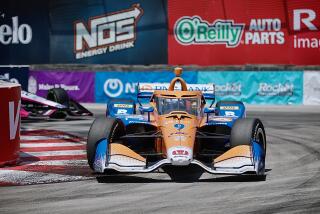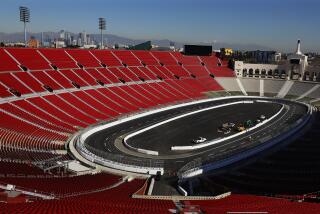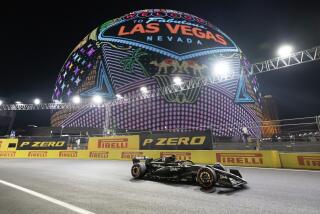Behind the wheel at speed
The Toyota Grand Prix takes over the streets of Long Beach this Sunday. Led by defending race champion Paul Tracy, 18 drivers will blister the harbor-area pavement. The open-wheel, carbon fiber, methanol-fueled cars driven at speeds up to 190 mph demand dragonfly reflexes, a surgeon’s hand-eye coordination and a cat-burglar’s cool. You can watch from the stands, but from the cockpit the view is different, described here by five of the top drivers as they approach various parts of the track -- something they must do 81 times to finish.
*
(BEGIN TEXT OF INFOBOX)
Champ Car
Engine: Turbocharged, 161-cubic-inch V8
Horsepower: 750
Acceleration: 0-100 mph in 4.2 seconds
Top speed: 240 mph
Fuel: Methanol
Minimum weight: 1,565 pounds; with driver and fuel, 1,900-2,000 pounds
Length: 15 feet, 10 inches
*
Leg 1: Smooth shifts, max speed
By A.J. Allmendinger
2004 Champ Car rookie of the year
Shift lights: ‘One bad shift could kill your straightaway speed.’
I watch shift lights for peak rpm in every gear. Start bending the car through long, fast ‘sweeper’ turn, keeping it right against the inside wall.
Before I can blink, go through sweeper at 190 mph; let the car drift outside when exiting the sweeper so I don’t scrub speed.
In seventh gear, at top speed. Begin to focus on turn 1, a second- or third-gear corner. Eyes focus on brake markers and pinpoint accuracy I need for brake zone.
*
Leg 2: Biggest braking zone
By Sebastien Bourdais
2004 Champ Car World Series champion
From 180 mph to 65 in a short amount of time. Very challenging because of its bumpiness. Keep as much speed as you can; flow is key.
‘Fountain’ corner: ‘You test your belts here.’
Accelerate to 100 mph then drop back to 45 for a difficult corner called the ‘fountain.’ It’s extremely hard not to lock right-front wheel. Traction issues common at exit.
Next curve is already here. It’s slippery and the wall is close at the exit.
*
Leg 3: Zero margin for error
By Ryan Hunter-Reay
Two-time Champ Car race winner
Exiting turn 5, the track is a concrete canyon. Will be focusing on braking point.
Control car, gain speed: ‘The car is very alive here, always moving around.’
Turn 6 falls away drastically. Front tires get traction first, so rear of car is a handful. I push extremely hard to catch the rear as it slides to the wall.
Now I have to get power for the straight ahead, climbing from second gear to the top of fourth.
*
Leg 4: Straightaway speed
By Bruno Junqueira
Three-time Champ Car runner-up
Shift, ‘pass’: ‘One of the better overtaking sections... is at the end of this straight.’
Put the power down all the way to sixth gear. A good overtaking position.
(Drivers can press the ‘Pass’ button for power boost to overtake other drivers.)
Brake late to turn 9, with fast downshift to second gear.
Right turn using inside curb. Car goes very close to the wall upon exiting the corner; prepare for the next corner.
*
Leg 5: The hairpin turn
By Justin Wilson
2004 runner-up for rookie of the year
Turn 10: ‘Flow speed through the left to help with the positioning.’
Carry speed into turn 10, coming very close to the wall on inside of the turn.
Tightest corner on the track. First gear! It’s all about positioning the car to help keep the speed up through the corner.
Apply power carefully, trying to use all 700 horsepower as early as possible. Big turbo, no traction control. It’s fun!
*
Sources: champcarworldseries.com; How Stuff Works; Four-time Long Beach Grand Prix winner Paul Tracy. Graphics reporting by Tom Reinken
*
Recent regional explainer graphics are available at latimes.com/localgraphics
More to Read
Go beyond the scoreboard
Get the latest on L.A.'s teams in the daily Sports Report newsletter.
You may occasionally receive promotional content from the Los Angeles Times.










